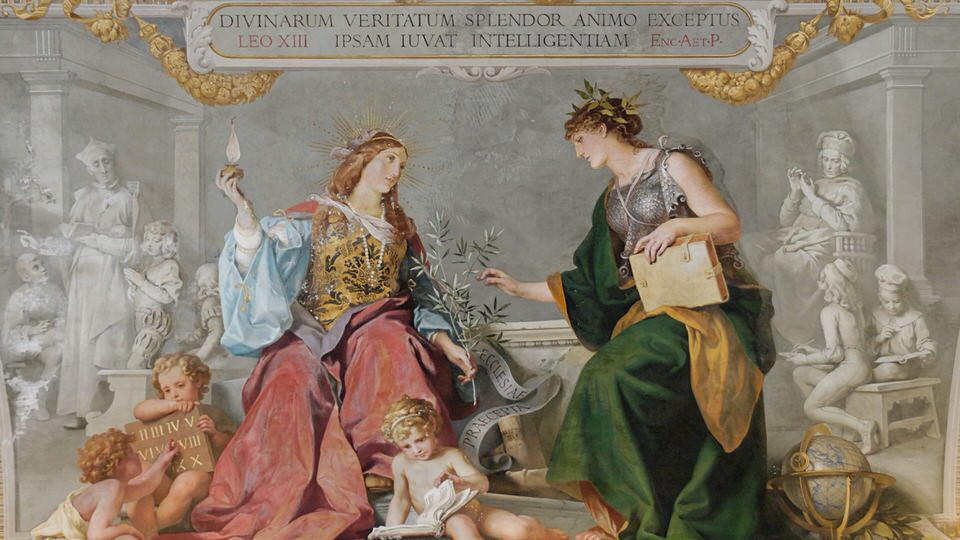

Leo XIII: A pope for our time
Benjamin Boivin
Tuesday, April 5, 2022

Faith and Reason United, a fresco by Ludwig Seitz in the Vatican Museums depicting the unity of faith (left) and reason in the teaching of St. Thomas Aquinas, accompanied by a quote from Aeterni Patris: "the splendor of the divine truths, received into the mind, helps the understanding" (Source: Wikimedia Commons)
Leo XIII can be described as the first modern pope. His unexpectedly long pontificate, spanning 25 years, brought the Church of the 19th century into the 20th. Regularly understood to be the founder of Catholic social teaching, Leo XIII's reign was characterized by a number of differences from that of his predecessor, Pope Blessed Pius IX.
Some of these differences have been accentuated to the point of unrecognizable parody, portraying the former as a liberal-leaning figure who embraced modernity and the latter as a reactionary and politically minded theocrat raging against the winds of the modern storm.
The reality is much different, as history shows that Leo XIII was involved in his predecessor's pontificate and active at high levels of Church authority throughout its most significant events, such as the First Vatican Council. Nonetheless, it is true that while Pius IX was very much active in the condemnation of some of the characteristic mistakes of the modern project, Leo XIII had a somewhat different approach, perhaps as a result of the particular set of circumstances which prevailed during his pontificate.
One of Pope Leo XIII’s main characteristics was, perhaps not unlike Pope Emeritus Benedict XVI, his intellectual gift. This particular charisma gave its flavour to a pontificate which addressed the issues of modernism with a more dialogical approach. Without pretending to exhaust the legacy of this great pastor, we could say that Leo XIII provided a three-legged stool on which Catholics could sit securely: Marian devotion, Thomism, and a rich understanding of new social problems.
In line with his immediate predecessor, Leo XIII provided thorough teachings on the paramount importance of Marian devotion, notably through the rosary and the scapular. A recourse to Mary cannot be described as a particularity of Leo XIII's, of course. Mary has been with the Church ever since her foundation and has always been profoundly revered by simple Catholics and sophisticated theologians alike. Yet, many would speak of the 19th century as an especially Marian one, considering the significant apparitions and doctrinal definitions that occurred then. Leo XIII encouraged it as a safe and secure way to reach out to God.
A more distinct aspect of Leo XIII's teachings, however, was that which regarded Thomism, the theology and philosophy of Saint Thomas Aquinas. Unparalleled in depth and soundness, Saint Thomas Aquinas' distinct approach of faith and reason, which provided for a form of synthesis between Aristotle's philosophical works and Christian revelation, was revived through the teachings of Leo XIII and his successors, who considered it especially capable of engaging with the ideologies of the time in an effective way.
Notably through the encyclical Aeterni Patris, Pope Leo XIII promoted what he called a ''restoration of Christian philosophy'' by encouraging philosophical work in the scholastic tradition associated with Saint Thomas Aquinas and, indeed, by further defining the particular authority which it holds, beyond other significant doctors of the Church. This encyclical and further development within Church teaching conferred upon Aquinas' work an unequalled normative strength, which is well expressed in titles associated with him: Doctor Angelicus (Angelic Doctor) and especially Doctor Communis (Common Doctor).
Leo's immediate successor, Pope Saint Pius X, for example, assisted by philosophers and theologians, defined in 1914 a comprehensive set of 24 Thomistic theses which are indicative of this movement within the Church towards the affirmation of the universal authority of Saint Thomas' legacy.
Pope Leo XIII's bet was that in an era that defined itself by its preoccupation with reason and science, Saint Thomas' works, characterized by a highly systematic and rational method, would provide the Church with the means to engage with the world and its pretenses with a formidable intellectual arsenal. Priests were to be educated in Thomistic philosophy and theology, major institutions of knowledge were dedicated to this work, and a comprehensive critical edition of Saint Thomas' works – the so-called Leonine edition – became a priority for the Church. For these reasons, Leo XIII's reign was as much a Thomistic pontificate as it was a social one.
Of course, though, Pope Leo XIII's best-known contribution to Church teaching from an historical standpoint is often considered to be the inception of Catholic social teaching (CST), through the publication in 1891 of Rerum Novarum, which was intended to address the ''revolutionary changes'' affecting the economic realities of the contemporary world, especially in Europe.
Much like the work of his predecessor, and consistently throughout Church teaching, Rerum Novarum constitutes a strong rejection of modern political ideologies, and especially in this case of economic liberalism and socialism. It puts forward a number of principles which together constitute the basis of modern CST in a context marked by the realities of an industrial economy which came to set a vast mass of impoverished workers against a very small number of extremely wealthy owners.
Leo XIII's vision was one of mutual rights and duties, affirming the right to form workers unions on the one hand and the right of private property on the other, for example. Drawing from this legacy, some Catholic intellectuals such as G. K. Chesterton and Hilaire Belloc attempted to formulate a third way between liberalism and socialism, what is often called distributism.
A foundational text in many regards, Rerum Novarum encapsulated some of the core principles of CST – the dignity of the human person, the common good, subsidiarity and solidarity – to such an extent that it was routinely revisited by his successors on significant anniversaries of its publication, starting with Pope Pius XI's Quadragesimo Anno in 1931 and throughout the 20th century after that.
We tend to speak of CST with Rerum Novarum in mind as a main point of reference. The Church, however, did not begin to teach about social and political questions in 1891. What changed is that it began to do so in a very distinct way so as to be able to approach a particular set of problems which had appeared at that time due to a radical reordering of societies as a result of the changes Pope Leo XIII addresses. In many regards, CST, with its preoccupation for the common good, is rooted in the Aristotelian-Thomistic thought which he helped to revive.
The world in which we now live is very different from that of 1891, and yet it faces problems which are fundamentally similar: extreme wealth disparity, political radicalization, and rejection of the faith as irrelevant were problems then just as they are now. Difficulties which appear new to us, like the climate crisis, often stem from previously misunderstood problems which have accordingly worsened.
The strength of Pope Leo XIII's answer is that it is in many ways timeless: it provides principles to pursue the common good for the political community from which we can derive solutions adapted to changing circumstances, points toward an intellectual framework which enables us to address challenges to the faith with strength and conviction, and shows the way of Marian devotion, an excellent remedy for those of us intellectually minded Catholics whose frail piety can deprive us of true Wisdom.
Related Articles:
<<













